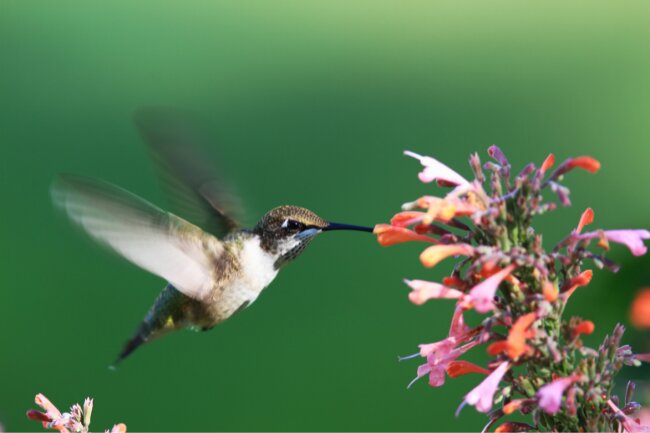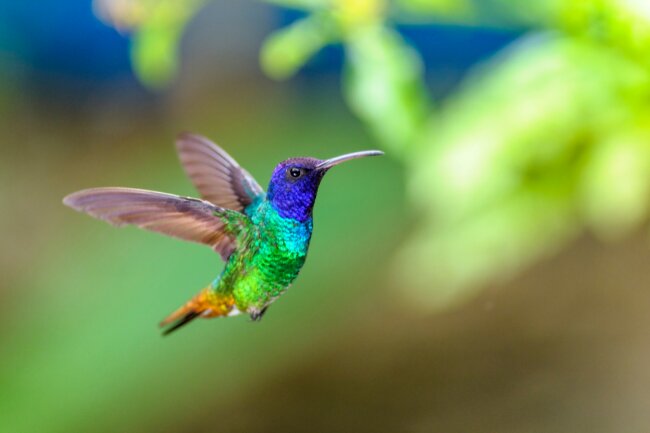Hummingbirds are attracted to a range of different flower species, but large, red, tubular flowers are often some of their favourites. As well as flowers it’s important to have good perching spots and water for these tiny visitors.
Contents
Hummingbird garden

There’s nothing more magical than a visit to your garden from a hummingbird. These tiny, and often glamorous visitors aren’t just a pleasure to see, they are also a part of the natural ecosystem, which our gardens are a part of.
In order to support this ecosystem, and encourage more hummingbirds to come and visit your green oasis, you can make sure there are certain features within your garden that hummingbirds benefit from.
| Common Name | Scientific Name |
|---|---|
| Bee Balm | Monarda spp. |
| Trumpet Vine | Campsis radicans |
| Cardinal Flower | Lobelia cardinalis |
| Salvia | Salvia spp. |
| Fuchsia | Fuchsia spp. |
| Penstemon | Penstemon spp. |
| Columbine | Aquilegia spp. |
| Red Hot Poker | Kniphofia uvaria |
Also read: Food and Feeding Habits of Hummingbirds?
Red flowers
All hummingbirds are nectarivores, this means they feed almost exclusively from flower nectar. They do this by hovering or perching before the flower and using their long tongue to slurp up the sweet liquid.
While hummingbirds will drink nectar from flowers of all different colours, they are particularly attracted to red flowers, so fill your garden with a splash of red and you can’t go wrong with these tiny birds.
Large, tubular flowers
As well as their colour, another aspect that attracts hummingbirds are the flower’s size and shape. Large flowers, with a tubular form, are perfect for them to feed from with their long beaks. Larger flowers are also easier to spot as they are passing by over head.
| Plant | Flower Color | Flower Shape |
|---|---|---|
| Bee Balm | Red, pink, purple | Tubular |
| Trumpet Vine | Orange, red | Trumpet-shaped |
| Cardinal Flower | Red | Tubular |
| Salvia | Red, purple, blue | Tubular |
| Fuchsia | Pink, purple, red | Bell-shaped |
| Penstemon | Red, pink, purple | Tubular |
| Columbine | Red, pink, yellow | Unique spurred shape |
| Red Hot Poker | Orange, red, yellow | Spiky clusters |
Perches
While hummingbirds are famous for hovering they also like to perch from time to time. Perching allows them to rest, preen and even sleep. Having mature trees to shrubs in your garden can provide an important service for visiting hummingbirds. They can also be vital for the birds safety, allowing them to hide away or rest out of reach of predators.
Water
Water is an important resource for many animals, particularly in drier or warmer areas. Providing water gives hummingbirds the chance to take a refreshing dip to clean their feathers, or guzzle down a mouthful before heading onwards.
Insects
Though hummingbirds are nectarivores they do also eat insects, and will particularly feed insects to their young. Therefore if you want to support hummingbirds throughout their lifecycle it’s good to have plenty of insects for them to eat as well. To do this simply plant your garden to benefit insects too, and avoid harmful pesticides.
Flowers for hummingbirds
While a general rule of thumb may be to plant large, tubular red flowers, in reality there are many different flowers that hummingbirds will visit and enjoy. Here are a few you might like to include in your garden to bring in these feathered visitors.
Bee balms
With pom-pom like flowers bee balms are a striking plant for any garden. Not only are they stunning to look at, they are also beloved by pollinators, with not just hummingbirds but bees and butterflies also visiting them.
Foxgloves
These towering pink flowers are well known from scenes of English country gardens, yet in America they have become so beloved by hummingbirds researchers have found the flower shape is slowly evolving to suit this tiny pollinator more and more.
Hummingbird mint
Also known as Hyssop, the hummingbird mint is a perennial plant whose jostling stems and columns of tubular flowers make it popular with gardeners. As its name suggests its leaves also have a wonderful minty freshness.
Desert candle
Desert candle flowers are certainly something to admire when they are in bloom. These tall spiked blooms come in golden yellows, pale whites and creamy peaches.
Coral bells
Coral bells are often planted not just for their wonderful flowers, but also for their large striking leaves. Beautifully variegated, these come in bright greens, deep purples and even golden yellows.
Beard tongue
There are over 250 Beard tongue species, also known as Penstemons. These long tubular flowers hang delicately down from the thin stems in brilliant blues, pinks and purples.
Red hot poker
Aptly named for their stunning colours, fading from bright orange down to yellow on their tower of densely packed flowers, the red hot poker is a beacon to passing hummingbirds. Originally from Africa it now grows wild in many parts of the US.
Trumpet honeysuckle
If you want to add flowers for hummingbirds without taking up huge amounts of space why not plant climbers like honeysuckle. The trumpet honeysuckle is particularly attractive, with its clusters of bright pink flowers.
Gardening for hummingbirds

When it comes to attracting hummingbirds into your garden remember that more is better. While hummingbirds will pop down to visit one patch of flowers, they are more likely to pop in if your garden is overflowing with blooms.
Depending where you live you might get hummingbirds all year round, or only in the summer. Making sure there’s always flowers available whenever your birds drop by is the best thing for them.
Spring and autumn can be particularly important times as they may be migrating or rearing chicks, which takes a lot of energy.
Nature can never be guaranteed, but the great thing about planting for hummingbirds is that even if the hummingbirds don’t drop by, you get to enjoy the wonderful flowers you’ve grown instead.

